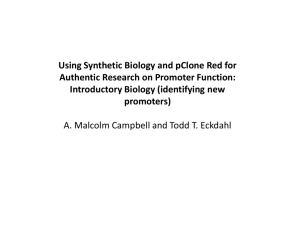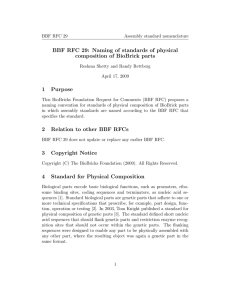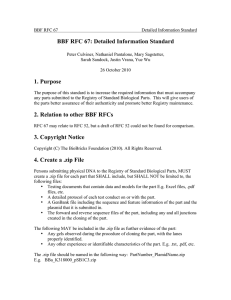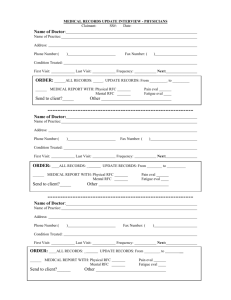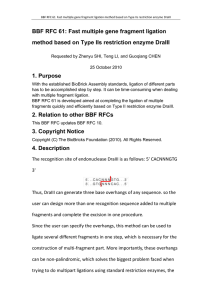BBF RFC 105: The Intein standard - a universal way
advertisement
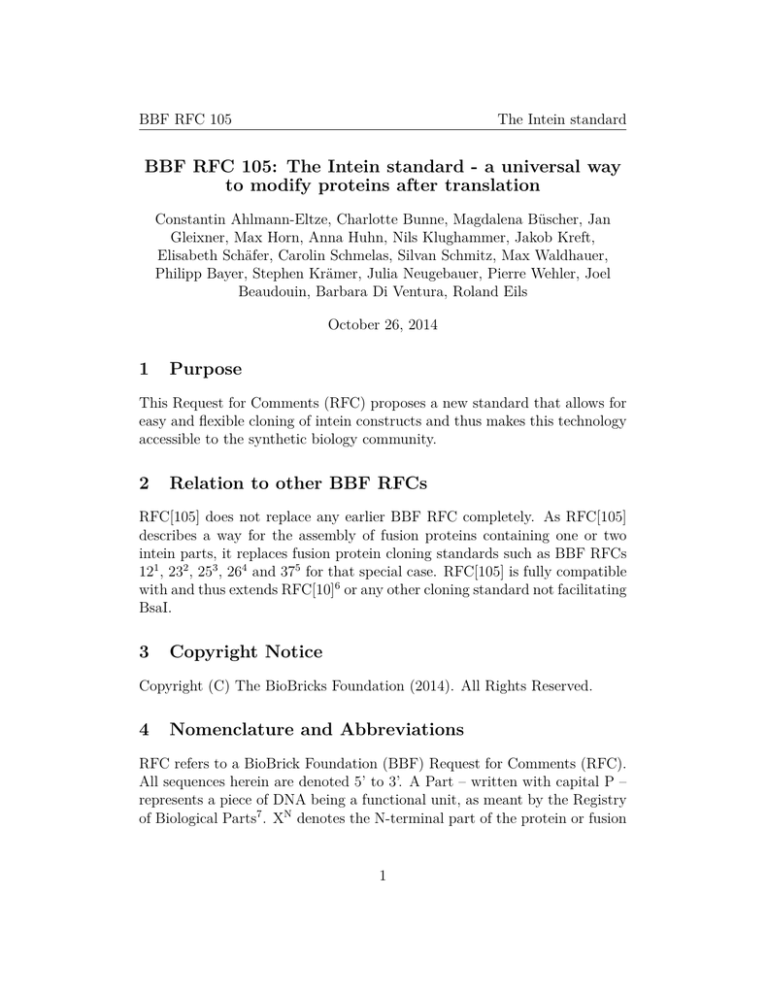
BBF RFC 105
The Intein standard
BBF RFC 105: The Intein standard - a universal way
to modify proteins after translation
Constantin Ahlmann-Eltze, Charlotte Bunne, Magdalena Büscher, Jan
Gleixner, Max Horn, Anna Huhn, Nils Klughammer, Jakob Kreft,
Elisabeth Schäfer, Carolin Schmelas, Silvan Schmitz, Max Waldhauer,
Philipp Bayer, Stephen Krämer, Julia Neugebauer, Pierre Wehler, Joel
Beaudouin, Barbara Di Ventura, Roland Eils
October 26, 2014
1
Purpose
This Request for Comments (RFC) proposes a new standard that allows for
easy and flexible cloning of intein constructs and thus makes this technology
accessible to the synthetic biology community.
2
Relation to other BBF RFCs
RFC[105] does not replace any earlier BBF RFC completely. As RFC[105]
describes a way for the assembly of fusion proteins containing one or two
intein parts, it replaces fusion protein cloning standards such as BBF RFCs
121 , 232 , 253 , 264 and 375 for that special case. RFC[105] is fully compatible
with and thus extends RFC[10]6 or any other cloning standard not facilitating
BsaI.
3
Copyright Notice
Copyright (C) The BioBricks Foundation (2014). All Rights Reserved.
4
Nomenclature and Abbreviations
RFC refers to a BioBrick Foundation (BBF) Request for Comments (RFC).
All sequences herein are denoted 5’ to 3’. A Part – written with capital P –
represents a piece of DNA being a functional unit, as meant by the Registry
of Biological Parts7 . XN denotes the N-terminal part of the protein or fusion
1
BBF RFC 105
The Intein standard
protein X. CDS refers to a coding sequence without stop codons. POI refers
to a protein/peptide of interest.
5
Motivation
Inteins are an amazing tool for synthetic biology: their ability for autocatalytic modification of 1-D protein structures allows their use for a great
variety of applications ranging from the purification of proteins, protein circularization, protein labeling and biosensing to the direct control of protein
activity.8
Each of these applications requires the combination of a protein/peptide
of interest with a set of inteins or split inteins, which have been characterized
previously. Standardization of the cloning process would enable the generation of such constructs from a very limited set of progenitor Parts. Modularization would allow the reuse of existing Parts and the easy exploration of
different inteins or exteins for a given task.
However, existing standards do not meet the requirements for such a standard, as they either leave scars at the splice site (RFCs[121 , 232 , 253 , 375 ]),
which compromise the functionality of the final constructs, or require custom
oligos (RFC[264 ]) and tedious backbone amplification(RFCs[289 , 5310 , 6111 ])
for each intein/extein combination.
Therefore, a new standard that allows for the easy and flexible cloning
of intein Parts based on six standardized overhangs and type IIs restriction
enzymes was developed, tested and will be described in the following.
6
Formal Description
RFC[105] describes the following nine types of constructs i.e. RFC[10] Parts,
each consisting of combinations of six sub-parts connected with one of eight
standard overhangs.
6.1
Parts
A Circularization/Oligomerization Part MUST contain a C-intein
sub-Part immediately followed by an insertion site, immediately
followed by an N-intein sub-Part. The C-intein sub-Part MUST
be in-frame with an ORF of the preceding elements. The preceding
2
BBF RFC 105
The Intein standard
elements SHOULD be either a RFC[10] prefix followed by an RBS and
a start codon or a RFC[10] prefix for CDSs followed by an ATG start
codon. The N-intein sub-Part SHOULD be followed by two TAA
stop-codons and the RFC[10] suffix. The sequence MUST not contain
any BsaI recognition sites other than the ones specified. See fig. 1 for
a graphical explanation.
.Xbal
rFC10 prefix] j(N)-POl-l(C) CDS selection markAr] Bsal
over ang CC
Circularisation Part
Translation
Complement
POl-inserti...
.
-C-intein
••
~ ~_[RFC10
s .ffix] Spel
N-intein-lii
TC TAGATGNNC AA CNGAGACCNNNNGG TCTCNT GCTNN TAA TAA TAC TAGT
M
N
C
.
?
*
*
A G A T ~T A C NN G TT GP C T C T GG NNNN CC AG A G N A C G APN A TT A TT A T G A T ~A
'
Bsal
Figure 1: Circularization/Oligomerization Part. Optional parts are
annotated with squared brackets. (visualized using [12])
An insert for Circularization/Oligomerization MUST contain the CDS
of a POI preceded by a BsaI recognition site, any single nucleotide and
overhang CC (GGTCTCNCAAC) and followed by overhang NN, any
single nucleotide and the reversed BsaI recognition site (TGCTNGAGACC).
It MAY be surrounded by RFC[10] prefix and suffix.
A N-intein assembly Part MUST contain the nucleotides GATG (overhang
A) immediately followed by an insertion site, immediately followed
by an N-intein sub-Part. The N-intein sub-Part should be followed by two TAA stop-codons and the RFC[10] suffix. A His6 tag or
any other additional CDS MAY be put before the stop codons. The
overhang A should be preceded by either the RFC[10] prefix and a
RBS or the RFC[10] prefix for CDSs shortened by the final G. The sequence MUST not contain any BsaI recognition sites other than the
ones specified. See fig. 2 for a graphical explanation.
3
BBF RFC 105
The Intein standard
[RF~~jql orefix) oveiang A
~·___.B
.......s.....
al_~·
,
l{N)-POljl{C) CDS
[selection marker]~N-assembly part
Translation
Complement
Spel
RFC10 suffix
TCTAGATGNGAGACC NNNNGG TCTCNTGCTNN TAA TAA TAC TAGT
C
M
?.
*
*
A G A T ~T A ~N C T C T GG NNNN CC A G A G N A C G ~NN A TT A TT A T G A T CA
ssa'1
Figure 2: N-intein assembly Part Optional parts are annotated with
squared brackets. (visualized using [12])
An N-intein insert MUST contain the CDS of a POI preceded by a BsaI
recognition site, any single nucleotide and overhang A (GGTCTCNGATG)
and followed by overhang NN, any single nucleotide and the reversed
BsaI recognition site (TGCTNGAGACC). The sequence SHOULD not contain any BsaI recognition sites other than the ones specified. It MAY
be surrounded by RFC[10] prefix and suffix.
A N-intein assembly Part with additional C-terminal insertion site
is a N-intein assembly Part that MUST have an additional insertion site preceded by NNTGGT (overhang NC) between the N-intein
sub-Part and the two TAA stop codons. The arbitrary NN nucleotides
SHOULD be GG so that the six additional nucleotides code for two Gly.
A C-intein assembly Part MUST contain a C-intein sub-Part, immediately followed by an insertion site, immediately followed by TAAT
(overhang Z) immediately followed by AA resulting in two TAA stopcodons. The C-intein sub-Part MUST be in-frame with an ORF of
the preceding elements. The preceding elements SHOULD be either
a RFC[10] prefix followed by an RBS and a start codon or a RFC[10]
prefix for CDSs followed by an ATG start codon. The sequence MUST
not contain any BsaI recognition sites other than the ones specified.
See fig. 3 for a graphical explanation.
4
BBF RFC 105
.
The Intein standard
[RFC10 suffix;.=~,;-,-----S...._p.......
el _
lntein(C)jPOI CDS
Xbal
.
[RFC1? prefix]
.-J.
cc~
-z-~
TTC T A G A T G NNNNTC AA C N G A G A C C NNNN G G T C T C NTT AA T AA T ATC T A G T
overhang
C-assemblyPart
Translation
Complement
____,
overhang
M
A G A T C.T A C NNNN G TT G.N C T c T G G NNNN C C A G A G N A TT A.TT A T G A T C.A
I
Bsal
Figure 3: C-intein assembly Part Optional parts are annotated with
squared brackets. (visualized using [12])
A C-intein insert MUST contain the CDS of a POI preceded by a BsaI
recognition site, any single nucleotide and overhang CC (GGTCTCNCAAC)
and followed by overhang Z, any single nucleotide and the reversed
BsaI recognition site (TAATNGAGACC). The sequence SHOULD not contain any BsaI recognition sites other than the ones specified. It MAY
be surrounded by RFC[10] prefix and suffix.
A C-intein assembly Part with additional N-terminal insertion site
is a C-intein assembly Part that MUST have an additional insertion
site preceded by GATG (overhang A) and followed by GGTG (overhang
CN) and two more nucleotides before the C-intein assembly Part.
The two nucleotides SHOULD together with the final G of overhang
CN code for a Gly. GT MAY be used.
An intein insert part contains a BsaI site followed by any single nucleotide, an N-intein sub-Part followed by the corresponding Cintein sub-Part followed by any single nucleotide and the reverse BsaI
recognition site. The sequence MUST not contain any BsaI recognition
sites other than the ones specified. It MAY be surrounded by RFC[10]
prefix and suffix.
A POI with insertion site MUST have overhang NN followed by an
insertion site and overhang CC inserted in frame into its CDS. The
sequence SHOULD not contain any BsaI recognition sites other than
the ones specified. It SHOULD be a valid RFC[10] Part.
6.2
Sub-Parts
An N-intein sub-Part is the CDS of an N-intein including the codon
for the first amino acid after the splice site, usually a Cys, but not the
5
BBF RFC 105
The Intein standard
codon for the last N-extein amino acid. The first four native nucleotides
MUST be changed to TGCT (overhang NN) (TGC coding for Cys). The
5th and 6th nucleotide SHOULD be changed such that they together
with 4th nucleotide T code for the the native or at least a similar amino
acid. For a non-splicing N-intein sub-Part overhang NN∗ (GGCT)
MUST be used instead of overhang NN.
A C-intein sub-Part is the CDS of a C-intein including the codon for
the last amino acid before the splice site, usually an Asn, but not the
codon for the first extein amino acid, usually a Cys. The last four
native nucleotides MUST be changed to CAAC (overhang CC) (the
AAC coding for Asn). The 6th and 5th last nucleotides SHOULD be
changed such that they together with 4th last nucleotide C code for
the the native or at least a similar amino acid. For a non-splicing
C-intein sub-Part overhang NN∗ (AGGC) MUST be used instead of
overhang CC.
An insertion site MUST start with an arbitrary nucleotide followed by
the reversed BsaI recognition site (GAGACC) and end with an arbitrary
nucleotide preceded by the BsaI recognition site (GGTCTC). This way
BsaI will cut the top strand 4 nucleotides upstream and directly downstream of the insertion site and the bottom strand directly upstream
and the bottom strand 4 nucleotides downstream of the insertion site.
The insertion site SHOULD contain a selection marker. An additional insertion site MAY use a reverse BsmBI (GAGACG) and a BsmBI
recognition site (CGTCTC) instead of the reverse BsaI and the BsaI site
respectively.
A selection marker MUST be a DNA sequence that if transformed into
a cell allows for selection of clones not carrying it. BBa_J04450 is
RECOMMENDED.
6.3
Standard overhangs
RFC[105] defines the following eight 4 nt standard overhangs that will allow
for flexible assembly of intein fusion proteins from progenitor parts without
interfering scars:
A: Sequence: GATG. This overhang contains an ATG start codon. It serves
as the connection between backbones and N-terminal POIs.
6
BBF RFC 105
The Intein standard
NN: Sequence: TGCT. This overhang codes for the first amino acid of Ninteins, a Cys, and for a third of the +2 amino acid, either a Phe, Leu,
Ser, Tyr, Cys or Trp.
NN∗ : Sequence: GGCT. Standard overhang for the assembly of non-splicing
control Parts. The GGC codes for a Gly instead of a Cys which acts as
the major nucleophile in the splicing process.
NC: Sequence: TGGT. This overhang codes together with the RECOMMENDED preceding GG for two Gly. It allows for the insertion of
an additional POI behind the C-terminus of N-Inteins.
CC: Sequence: CAAC. This overhang codes for an Asn, the last amino acid
of C-inteins, and for one third of -2 amino acid. It allows to connect
POIs with C-intein CDSs.
CC∗ : Sequence: AGGC. Standard overhang for the assembly of non-splicing
control Parts. The GGC codes for a Gly instead of Asn which seems to
be required for C-terminal cleavage. Like overhang CCit is used to
connect POIs with C-intein CDSs.
CN: Sequence: GGTG. This overhang codes together with the RECOMMENDED following GT for two Gly which serve as linker between the
N-terminus of a C-intein sub-Part and additional POI CDSs.
Z: Sequence: TAAT. This overhang builds together with the RECOMMENDED
following AA two TAA stop codons and serves as the connection between
C-terminal POIs and backbones.
7
Usage
Fusion protein Parts with Inteins can be easily assembled from RFC[105]
conforming progenitor Parts using a one-pot Golden Gate13 assembly reaction. The protocol listed in appendix 10.1 MAY be employed to perform this
reaction.
If the progenitor parts include additional BsaI sites, the user SHOULD
perform an additional religation step after the Golgen Gate assembly reaction. The protocol listed in appendix 10.2 MAY be employed to perform
this reaction. In that case, the progenitor part MUST contain a selection
marker, as the original backbone will recircularize.
7
BBF RFC 105
The Intein standard
Progenitor Parts MAY be assembled using Circular Polymerase Extension
Cloning (CPEC)14 or High Throughput CPE Cloning and Transformation
(HiCT), as described in BBF RFC 9915 . Inserts, if not available on plasmids,
MAY be created using an extension PCR reaction, which adds the flanking
BsaI sites as described above. It is then RECOMMENDED to also introduce
this part into a standard RFC[10] backbone, so that the flanked insert created
by the aforementioned extension PCR is available for future assemblies.
Inteins can be used to circularize or oligomerize proteins by fusing a Cintein to the N-terminus of that protein and the corresponding N-intein to the
C-terminus (IC -POI-IN ). See fig. 4a for a schematic overview of the assembly
of such parts using standard constructs. Figure 4b gives an example of how
intein assembly Parts may be used to add a tag to a POI after translation.
A similar strategy can be used for most other intein parts.
8
Discussion
Standardization of overhangs between distinct groups of functionally related
parts bears a big advantage. It allows reusing these parts for different assemblies, eliminates the need for the design of custom cloning strategies and
eases the overall process. However, they usually come at the cost of interfering scars introduced at the ligation site.
RFC[105]was specifically designed to overcome this problem by defining
functional standardized overhangs. The defined overhangs are either part
of existing standards (overhang A, overhang Z), code for short Gly linkers that minimize interference of Tags or other POIs with intein domains
(overhang NC, overhang CN) or are highly conserved motifs in intein
sequences (overhang NN, overhang CC). The latter are most relevant
for the intein function: Additional amino acids that would be introduced
by a scar would also appear in the spliced proteins and thus hinder the design of optimal linkers for circularization and render protein activation by
reconstitution of the active site of enzyme impossible.
Overhang NN can code for the N-terminus of 50.3 % of all N-inteins
listed in the intein database InBase16 . This does not decrease the potential
of the proposed method, since those amino acids could be substituted by
chemically similar ones and the most promising inteins like Npu DnaE or
gp41-1 are compatible. The aspartic acid at the C-terminus of C-inteins is
even more conserved so that 93.1% of all intein C-termini resemble overhang
8
BBF RFC 105
The Intein standard
BsaI
BsaI
CAAC
GTTG
POI 1
TGCT
ACGA
linker
BsaI
coding region
BsaI
IC CAAC
BsaI
selection marker
GTTG
CAAC
GTTG
coding region
TGCT I
ACGA N
coding region
GoldenGate reaction
IC
POI
Linker
BsaI
selection marker
GTTG
GATG
CTAC
coding region
BsaI
IC CAAC
BsaI
BsaI
TAAT
ATTA
POI 1
coding region
GATG
CTAC
TGCT
ACGA
coding region
BsaI
TAATAA
ATTATT
IN
BsaI
POI 2
BsaI
selection marker
TGCT I
ACGA N
coding region
GoldenGate
reaction
expression
IC
cleaved off
inteins
POI 1
linker
IC
POI 2
IN
IC
trans-splicing reaction
circular protein
with designed linker
linker
IN
coexpression
splicing reaction
IN
POI 2
POI
IC
IN
POI 1
POI 1+2
IN
cleaved off
inteins
IC
POI
(a) Protein circularization
(b) Protein assembly
Figure 4: Usage example of standard circularization and assembly Parts.
(a) Use of the Circularization/Oligomerization Part with a insert for
Circularization/Oligomerization for the generation a circular protein.
(b) Usage of the N-intein assembly Part with an N-intein insert and
the C-intein assembly Part with a C-intein insert.
9
BBF RFC 105
The Intein standard
(a) Anti-His Western blot image
that shows the circularization of λlysozyme using an RFC[105] Npu
DnaE circularization Part.
(b) Western blot image that shows
the reconstitution of split sfGFP using the Npu DnaE split intein.
Figure 5: Example results of applications of standard circularization and
assembly Parts.
CC.
The described standard was extensively used by the iGEM Team Heidelberg for the circularization of several enzymes and the reconstitution of
split fluorescence proteins. Moreover an intein toolbox was build around it.
For instance BBa_K1362000, BBa_K1362100 and BBa_K1362101 represent respectively a RFC[105] conform Circularization/Oligomerization
Part, N-intein assembly Part and C-intein assembly Part utilizing
the Npu DnaE intein. Figure 5 shows exemplary results of the successful
application of the herein described methods. Visit the team wiki (http:
//2014.igem.org/Team:Heidelberg) for detailed information.
9
Authors’ Contact Information
Constantin Ahlmann-Eltze: constantin.ahlmann@t-online.de
Charlotte Bunne: bunne@stud.uni-heidelberg.de
10
BBF RFC 105
The Intein standard
Magdalena Büscher: m.buescher@dkfz-heidelberg.de
Jan Gleixner: jan.gleixner@gmail.com
Max Horn: maexlich@gmail.com
Anna Huhn: anna.g.huhn@gmail.com
Nils Klughammer: klughammer@stud.uni-heidelberg.de
Jakob Kreft: jakob@kreft-mail.de
Elisabeth Schäfer: lisl@schaeferhome.de
Carolin Schmelas: schmelas@stud.uni-heidelberg.de
Silvan Schmitz: silvan@silvanschmitz.de
Max Waldhauer: waldhauer@stud.uni-heidelberg.de
Philipp Bayer: philipp.bayer@lab-alumni.de
Stephen Krämer: stephenkraemer@gmail.com
Julia Neugebauer: julia.neugebauer@bioquant.uni-heidelberg.de
Pierre Wehler: pierre.wehler@bioquant.uni-heidelberg.de
Joel Beaudouin: j.beaudouin@dkfz.de
Barbara Di Ventura: barbara.diventura@bioquant.uni-heidelberg.de
Roland Eils: r.eils@dkfz.de
References
1. Knight, T. BBF RFC-12 Draft Standard for Biobrick BB-2 Biological
Parts. BioBricks Found. Req. Comments. <http://hdl.handle.net/
1721.1/45138> (2007).
2. Phillips, I. & Silver, P. A New Biobrick Assembly Strategy Designed for
Facile Protein Engineering. BioBricks Found. Req. Comments. <http:
//hdl.handle.net/1721.1/32535> (2006).
3. Müller, K., Arndt, K., iGEM 2007 Team Freiburg & Grünberg, R. BBF
RFC 25: Fusion Protein (Freiburg) Biobrick assembly standard. BioBricks Found. Req. Comments. <http://hdl.handle.net/1721.1/
45140> (2009).
4. Sleight, S. C. BBF RFC 26: In-Fusion BioBrick Assembly. BioBricks
Found. Req. Comments. <http://hdl.handle.net/1721.1/46328>
(2009).
11
BBF RFC 105
The Intein standard
5. Benčina, M. & Jerala, R. BBF RFC 37 : Fusion protein BioBrick assembly standard with optional linker extension. BioBricks Found. Req.
Comments. doi:http : / / hdl . handle . net / 1721 . 1 / 73912. <http :
//hdl.handle.net/1721.1/46705> (2009).
6. Knight, T. Draft Standard for Biobrick Biological Parts 2007. <http:
//hdl.handle.net/1721.1/45138>.
7. Selvarajah, V. What are biological parts 2013.
8. Wood, D. W. & Camarero, J. a. Intein applications: from protein purification and labeling to metabolic control methods. J. Biol. Chem. 289,
14512–9. issn: 1083-351X (May 2014).
9. Peisajovich, S. G., Horwitz, A., Hoeller, O., Rhau, B. & Lim, W. BBF
RFC 28: A method for combinatorial multi-part assembly based on the
Type IIs restriction enzyme AarI. BioBricks Found. Req. Comments,
1–5 (2009).
10. Jiang, H. et al. BBF RFC 53: USTC MetaPart Assembly Standard –
Extending RFC 10 to Enable Scarless Protein Fusion with Type IIS
Restriction Enzyme EarI and SapI. BioBricks Found. Req. Comments,
1–28 (2010).
11. Shi, Z., Li, T. & Chen, G. BBF RFC 61: Fast multiple gene fragment
ligation method based on Type IIs restriction enzyme DraIII. BioBricks
Found. Req. Comments. <http://hdl.handle.net/1721.1/59802>
(2010).
12. Biomatters. Geneious version 7.1 <http://www.geneious.com>.
13. Engler, C., Kandzia, R. & Marillonnet, S. A One Pot, One Step, Precision Cloning Method with High Throughput Capability. PLoS ONE 3,
e3647 (Nov. 2008).
14. Quan, J. & Tian, J. Circular polymerase extension cloning of complex
gene libraries and pathways. PloS one 4, e6441 (2009).
15. Beer, R. et al. BBF RFC 99: HiCT: High Throughput Protocols For
CPE Cloning And Transformation (2013).
16. Perler, F. B. InBase: the Intein Database. Nucleic Acids Res. 30, 383–4.
issn: 1362-4962 (Jan. 2002).
12
BBF RFC 105
10
The Intein standard
Appendix: Recommended materials and methods
10.1
Golden Gate Assembly (cycling)
• Mix 150 ng of the backbone and equimolar amounts of the insert(s) in
water in a PCR tube for a total volume of 15 µL.
• Add 1.5 µL of 10X T4 Ligase Buffer and, when using BsaI or another
restriction enzyme that requires it, BSA (Bovine Serum Albumin) at a
final concentration of 1X.
• Add 1 µL of each restriction enzyme and 1 µL of T4 DNA Ligase (400,000
cohesive end ligation units/ml).
• Optional: Add 1 µL of T4 Polynucleotide Kinase, if several inserts without 5’-phosphorylation (e.g. annealed oligos) are used.
• Place the reaction in a thermocycler and run the following program:
25 cycles of 4 min ligation at 16 ◦C, 3 min restriction at 37 ◦C, 5 min
at 50 ◦C (final restriction) and 5 min of heat inactivation at 80 ◦C.
10.2
Religation after Golden Gate Assembly
• Add 12.5 µL of water, 1.5 µL of T4 Ligase Buffer and 1 µL of T4 DNA
Ligase to your Golden Gate reaction.
• Incubate for 20 min at 16 ◦C, then heat inactivate for 10 min at 65 ◦C.
13


